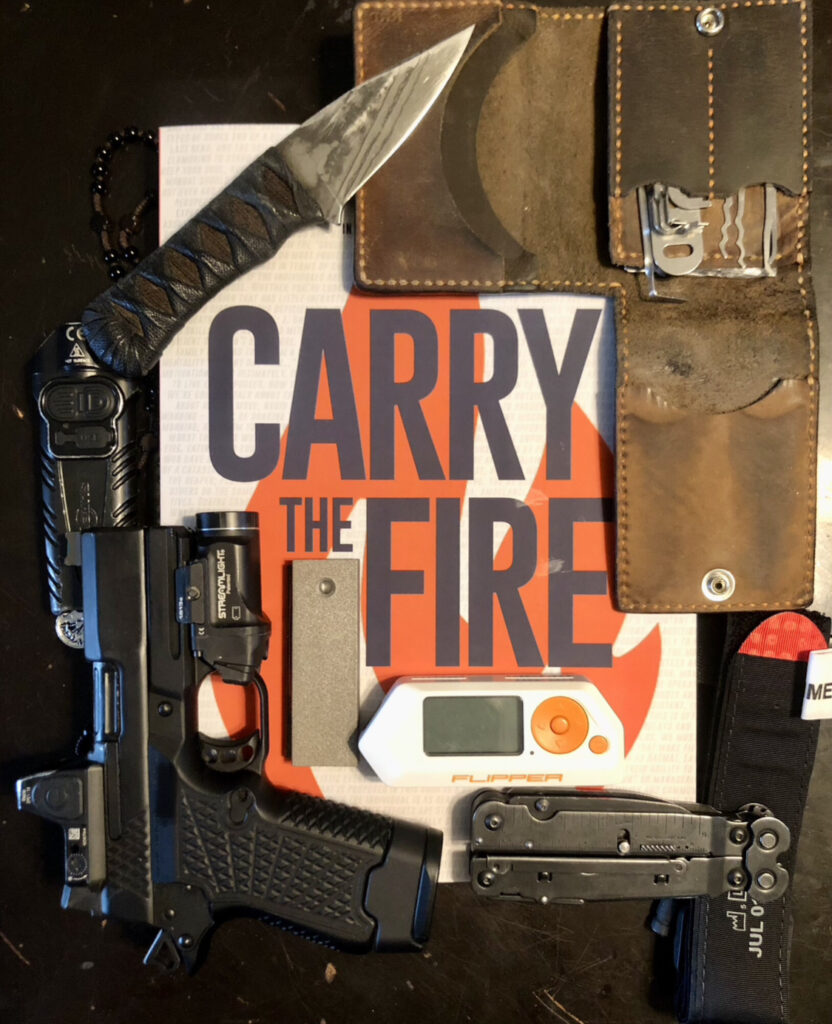
Carry the Fire: Author’s Notes on Rethinking Emergencies
Flashback: ISG had been a public entity for a year or two after Gino and I met, and people started making a request. They’d ask “why not make this into a book?” After all, if there was a real emergency, access to the internet might be down. The idea of having a physical reference made a lot of sense.
The reasons, as it turned out, weren’t easy ones, but here are my excuses anyway:
-
- People really don’t read all that much.
-
- It’s costly to self-publish, and soul crushing to be continually rejected by publishers.
-
- I’ve got a really weak background in writing formally. I’m the guy who got made fun of for not knowing “their” from “there” until I was in my 20’s. Ironically, this is part of what makes ISG and Carry the Fire a little less pretentious, and finally;
-
- It’s often seen as a ‘niche’ subject.
Me doubting the viability of an idea because I don’t want to get dumped on by hoards of online naysayers wasn’t something new. After all, we’ve often said “it takes decades to gather experience, years to synthesize it into actionable information, months to draft articles, and a day to publish, but it takes about 30 seconds for someone to ruin your day by sh**ing on your efforts.” Ultimately, that’s sort of a copout. So, the last couple years, and about $10,000 later, we have the book that people asked for.
A Niche for Everyone
A quick story. I came into a local coffee shop, thrilled to have just signed my first book, and prepared to hand deliver it to the gal who’d bought it. Another older gent I know asked me what it was about and so I gave him the elevator pitch (which admittedly changes every time). He looked at me and goes “You’re a bright kid, why not write something people will actually read? Something that isn’t so niche? What can an old guy like me do with that?”
You know how people say “I’m GLAD you asked!”? I wasn’t. The comment annoyed me, to be honest, because I wrote the stupid book, and I knew what was in it. I was certain that he’d find exactly what others were finding*… but he couldn’t imagine how being better prepared for emergencies could be relevant to him. He believed, as it turned out, that he had nothing to offer.
Well, allow me to retort
Here’s the thing, though. Every single day of our lives, we are “offering something”. Some of us live hard lives in which every day is a struggle. Others find their most difficult challenge deciding where to eat… but these are all tied directly back to the Rules of Three. Every single day, each and every one of us addresses this. Sometimes we do it by dressing for the weather. Sometimes by filling our gas tank up ahead of a hurricane. Some days, it’s by remembering to carry a water bottle. We don’t think of it like that because this is common.
But it’s literally a niche component of life that we all experience.
So why shouldn’t everyone have access to information on how to dead with it when common days turn uncommon?
In short, it’s my hope that any human on the planet could crack the book and find at least one tip, trick, or approach that does them a minimum of $20 of good in their life.
Approachability
As the saying goes, it takes 10 compliments to offset a criticism. I’m always waiting for criticism to drop, though. It’s not that I like it, it’s that it is usually honest. When people give you bad news, it’s hard for them. It can be uncomfortable for them. Therefore, they have to summon some courage to even bring it up. There’s something to that… and this is where the surprise hits.
Most of the feedback has been honestly good. The book is said to be readable, approachable, actionable, and, most important, relevant to the readers. As an author, the type of which is always waiting for bad news, I can’t say how encouraging that is. People have to give it a chance, but the ones who do are finding it to be approachable, and I couldn’t ask for much more than that.
But there’s always room for…
Improvement. The continual whipping post of ISG. There were some things people didn’t like, and here I’d like to offer a couple things: explanation, and correction. First and foremost, some people didn’t like the formatting of the initial effort. The book was BIG – like college textbook big. The spacing was ample, and the margins were too. One of the earliest critiques was “whoever decided on this should rethink their life decisions”, you don’t need that much space to highlight, after all.
The reviewer later deleted that criticism, but I appreciated it. It gave ME actionable feedback, which again, is what ISG is about. So, let me explain why I did that, and why I rethought my life decisions:
-
- Line spacing – This one was because I wanted it to be easy to read for people who were either newer readers, or had aged eyes. Wider spacing makes it easier to read, and if you find yourself in low light, with your kid reading to you while you’re inventorying your food in the dark, I had hoped this would help.
-
- Margins – The margins are simple! Note taking. Sometimes highlighting is enough, but sometimes you need to scribble notes to yourself. I wanted to ensure people wouldn’t run out of space, though maybe I over-estimated the need.
-
- Size – Lastly, the size of the book. Why is it huge? Well, here’s the God’s Honest. We finished the cover design before making the decision to remove the images. So the art was done (beautifully, thanks to Burg Design), and going back to the drawing board to resize the thing was holding up the delivery on a product that was “finished”. I got impatient. Mea Culpa on this one.
So I guess with that acknowledged, it’s time to talk about what to do about it.
V2 vs Edition F
So with the formatting eccentricities, we had to scramble to make sure there was an alternative. Obviously the F in Edition F stands for formatting. Enter V2. The second version, now in 6×9″, has some of the same features (margins) with some differences (smaller text), and is a bit more portable. The eReader version likewise had some automatic formatting anomalies that I think anyone who’s picked up an eReader knows just seem to synthesize out of the ether. In any case, I can’t say that V2 is going to make everyone happy all the time, but I do hope it serves as a testament to one thing: my willingness to continue improving the effort.
Conclusion
Here we are, dear reader, at the end of this introduction. The first words I’ve written about the book outside the endless infomercial that is social media. In Carry the Fire, the end of the book intentionally leaves the reader feeling overwhelmed. Readers have contacted me and said “I don’t know where to start! I feel like I don’t know anything!”
The place to start is at the beginning, knowing the end. There’s a final, subtle lesson in there. We can’t do it alone. It’s just too much to be everything to everyone, all the time.
We all need help, sometimes. This applies to me, as well. So, I’ve got a few asks:
I absolutely hate hate hate the idea of selling the soul of ISG for advertising. Not only does it seem vapid, but it seems dishonest. Of course I want people to buy the book. I’m still bailing water from taking on the cost of publishing, but it’s still more important to me that the value comes not from a sales pitch, but the intrinsic benefits of having it as a reference.
Please Consider doing the following:
-
- If you’ve read it and are happy with it, recommend it to a friend! It’s now available on our ISG shop, as well.
-
- If you want to order it, request it at your local book store. The ISBN’s are here:
-
- Ingram Spark (Discount bulk pricing, returnable)
-
- Print ISBN 979-8-9850006-2-7
-
- Ebook ISBN 979-8-9850006-1-0
-
- Ingram Spark (Discount bulk pricing, returnable)
-
- Amazon (Kindle Direct Publishing)
-
- Print 979-8-9850006-3-4; ASIN: BOBMXYM1M1
-
- eReader 979-8-9850006-1-0 ASIN: BOBKYFBCSX
-
- Amazon (Kindle Direct Publishing)
-
- Flash them the QR Code to the right
-
- If you want to order it, request it at your local book store. The ISBN’s are here:
-
- If you’ve read it and are happy with it, leave a positive review! Amazon and GoodReads reviews go a long way in helping others make the decision to buy it. Let people know this isn’t just another doomsday survival guide. If you’re not happy with it, contact us at [email protected].
That’s it. Thank you all for the support. The fact that this article is a thing is nothing short of amazing to me, and it’s a direct reflection of the support and strength of ISG’s supporters.
Thank you all.
Aaron
*That there are things you can do right now to improve your lot, and that no one of us is able to do it all!
…Oh yeah, and keep your ears open for an audiobook version.




